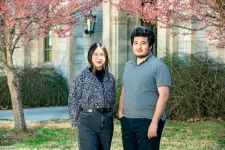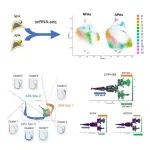(Press-News.org) Suppose two speakers of the same language are playing a guessing game where each has the same color swatches, and Player 1 tries to get Player 2 to guess a hue by naming the color. If the second player consistently guesses correctly as often as possible, that indicates their language has an efficient color naming system.
Past research has shown that efficient color vocabularies are constrained both by how people perceive colors and by how much they want or need to communicate about a given color. For example, Penn researchers found in a 2021 study that the need to communicate about reds and yellows is high across languages, while greens are more important in some languages.
Now, Penn scientists have identified another constraint: history. Colin R. Twomey, interim executive director of the Data Driven Discovery Initiative in the School of Arts & Sciences, worked with psychology professor David H. Brainard and biology professor Joshua B. Plotkin in a new paper showing how a language’s past color vocabulary shapes its ability to evolve, shedding light on how the number and meaning of color words have changed over time. Their work is published in Proceedings of the National Academy of Sciences.
“The main takeaway is that, once you as a linguistic community have an efficient vocabulary, that starting point restricts the next possible efficient vocabulary that you could have when you introduce a new term,” says Twomey, the first author. “As the vocabulary grows, the number of different vocabularies that you could move to is increasingly constrained.”
This takeaway shares a principle with evolutionary biology. The existence of an evolutionary pathway limits available future pathways, compared to the number of options available if a species were to arise anew. Plotkin and Twomey come from a background in evolutionary theory for biology, and here they are trying to better understand how some of the same theory applies to cultural evolution.
The authors used the publicly available World Color Survey (WCS), in which about 25 speakers from each of 110 languages were asked to name the same set of 330 color stimuli. This dataset provides the likelihood that a speaker from each of the languages would use a certain term to describe a color.
The WCS was the work of anthropologist Brent Berlin and linguist Paul Kay, who identified 11 color categories in English: red, orange, yellow, green, blue, purple, pink, black, white, brown, and gray. While English uses 11 color categories, the most common color vocabulary size among WCS languages is six words.
Using the WCS, the Penn researchers explored the introduction of new terms and the probability that a given word will change meaning as the size of the color vocabulary increases. For example, a term identified as green-blue could shift in meaning to “green” if a new term is established as “blue.” Green-blue and blue are quite susceptible to changes in meaning as new terms are added, whereas red, black, and yellow remain relatively stable in meaning.
One example the authors show is a color vocabulary that evolved into a six-word set with red, pink, yellow, black, white, and a green-blue shade. But if one were to make a six-word vocabulary from scratch—de novo—based on the same communicative needs for that language, the vocabulary could instead have separate colors for green and blue and still include red but have no word for pink, and it would still be efficient. Moreover, and despite facing the exact same constraints, from there the historical vocabulary would most likely split green-blue into separate terms whereas the de novo vocabulary is more likely to introduce light green or orange than pink.
“Since we know that history matters, it means we can infer history from the present language state. In principle, we can infer what ancestral color vocabularies were and then compare that to the historical record,” Plotkin says. An example he provides is that at certain points in history, certain commercial dyes were introduced that became economically important to a culture.
The paper also notes that history should also constrain how people talk about and categorize aspects of culture aside from color; Plotkin and Brainard respectively point to the ways we categorize consumer products and weather conditions, for example.
Their color study “represents a general theory that categories are refined based on communicative needs, historical constraints, and this principle of efficiency,” Brainard says. “The ideas, we would hope, would apply to how we name and categorize and communicate about all kinds of things.”
This study was supported by a postdoctoral fellowship through the University of Pennsylvania’s Data Driven Discovery Initiative and the John Templeton Foundation (Grant 62281).
Colin R. Twomey is the interim executive director of the Data Driven Discovery Initiative and at the time of this study was a postdoctoral fellow in the Department of Biology in the University of Pennsylvania School of Arts & Sciences.
Joshua B. Plotkin is the Walter H. and Leonore C. Annenberg Professor of the Natural Sciences in the Department of Biology in Penn Arts & Sciences.
David H. Brainard is the RRL Professor of Psychology in in Penn Arts & Sciences.
END
The role of history in how efficient color names evolve
2024-03-01
ELSE PRESS RELEASES FROM THIS DATE:
AI outperforms humans in standardized tests of creative potential
2024-03-01
Score another one for artificial intelligence. In a recent study, 151 human participants were pitted against ChatGPT-4 in three tests designed to measure divergent thinking, which is considered to be an indicator of creative thought.
Divergent thinking is characterized by the ability to generate a unique solution to a question that does not have one expected solution, such as “What is the best way to avoid talking about politics with my parents?” In the study, GPT-4 provided more original and elaborate answers than the human participants.
The study, “The current state of artificial intelligence generative ...
Study results show 25% of pregnant people are not getting enough omega-3 fatty acids from their diet or dietary supplements
2024-03-01
Boston, MA – Results from a new nationwide cohort study show that, despite strong recommendations in favor of consuming omega-3 fatty acids for optimal pregnancy outcomes and offspring health, 25% of participants reported rarely, or never eating fish during pregnancy, with fewer taking omega-3 supplements.
The study, “Demographic and health characteristics associated with fish and n-3 fatty acid supplement intake during pregnancy: results from pregnancy cohorts in the ECHO program” was led by investigators at the Harvard Pilgrim Health Care Institute and published February 27 in Public Health Nutrition. The study is timely, ...
Cleveland Clinic researchers uncover how virus causes cancer, point to potential treatment
2024-03-01
March 1, 2024, Port St. Lucie, Fla: Cleveland Clinic researchers have discovered a key mechanism used by Kaposi's sarcoma-associated herpesvirus (KSHV), also known as human herpesvirus 8 (HHV8), to induce cancer. The research points to effective new treatment options for KSHV-associated cancers, including Kaposi’s sarcoma, primary effusion lymphoma, and HHV8-associated multicentric Castleman disease.
“Our findings have significant implications: viruses cause between 10% to 20% of cancers worldwide, a number that is constantly increasing ...
SLU professor studies link between adversity, psychiatric and cognitive decline
2024-03-01
Saint Louis University associate professor of health management and policy in the College for Public Health and Social Justice, SangNam Ahn, Ph.D., recently published a paper in Journal of Clinical Psychology that examines the relationship between childhood adversity, and psychiatric decline as well as adult adversity and psychiatric and cognitive decline. His team discovered that just one instance of adversity in childhood can increase cases of mental illness later in life, and adverse events in adults can lead to a greater chance of both mental ...
Warwick to benefit from £2.5 million funding into “phenomenal” metamaterials
2024-03-01
A £2.5m grant will enable a new network driving research into metamaterials, headed up by a researcher from the University of Warwick.
Metamaterials have phenomenal potential. They are artificial 3D structures comprised of at least two different materials. This combination and the structure give metamaterials properties beyond those of the materials used to make them. These properties may be electromagnetic, acoustic, magnetic, mechanical/structural, thermal, or chemical.
Metamaterials could transform our economy in a digital age, helping to address society’s challenges by contributing to manufacturing in areas of sustainability, health care, ...
More schooling is linked to slowed aging and increased longevity
2024-03-01
Participants in the Framingham Heart Study who achieved higher levels of education tended to age more slowly and went on to live longer lives as compared to those who did not achieve upward educational mobility, according to a new study at Columbia University Mailman School of Public Health and The Robert N. Butler Columbia Aging Center. Upward educational mobility was significantly associated with a slower pace of aging and lower risk of death. The results are published online in JAMA Network Open.
The Framingham Heart Study is an ongoing observational study first initiated in 1948 that currently spans three generations.
The Columbia analysis is ...
Trends in recurring and chronic food insecurity among US families with older adults
2024-03-01
About The Study: The results of this study highlight how rates of recurring and chronic food insecurity among families with older adults rose substantially over the past 20 years. Monitoring national trends in food insecurity among older adults has direct programmatic and policy implications.
Authors: Cindy W. Leung, Sc.D., M.P.H., of the Harvard T.H. Chan School of Public Health in Boston, is the corresponding author.
To access the embargoed study: Visit our For The Media website at this link https://media.jamanetwork.com/
(doi:10.1001/jamahealthforum.2023.5463)
Editor’s ...
Self-reported everyday functioning after COVID-19 infection
2024-03-01
About The Study: The findings of this study of 372 veterans suggest that the negative impacts of the COVID-19 pandemic on everyday function may occur via multiple pathways regardless of whether or not they had a documented infection with COVID-19. Future work with larger samples is needed to validate the estimated associations.
Authors: Theodore J. Iwashyna, M.D., Ph.D., of Ann Arbor VA in Ann Arbor, Michigan, is the corresponding author.
To access the embargoed study: Visit our For The Media website at this link https://media.jamanetwork.com/
(doi:10.1001/jamanetworkopen.2024.0869)
Editor’s ...
The surprisingly complex inner workings of an endocrine tumor
2024-03-01
Researchers from Tokyo Medical and Dental University (TMDU) find that the cells that make up aldosterone-producing adenomas become more transcriptionally active and express higher levels of genes linked to hormone production over intratumoral differentiation.
Tokyo, Japan – There is strength in teamwork, and it turns out that this applies to tumors, too. Researchers from Japan have reported that different types of cells within a single benign tumor may work together to promote the tumor’s growth.
In a study published this ...
Safety assessments for older drivers would benefit from introducing spatial orientation tests
2024-03-01
Older drivers who have worse spatial orientation ability experience greater difficulty when making turns across oncoming traffic, according to new research from the University of East Anglia (UEA).
Spatial orientation skills are the combination of skills that enable us to mentally determine our position, or the position of our vehicle and other vehicles, relative to the environment.
Lead author Sol Morrissey, a PhD researcher at UEA’s Norwich Medical School, said: “Driving safety is typically reduced in older adults due to changes that take place during ...

